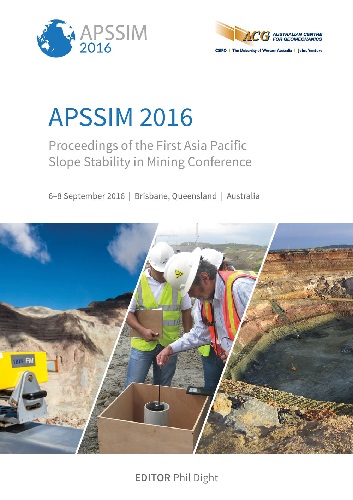Structural domain determination — practicality and pitfalls

|
Authors: Mathis, JI |
DOI https://doi.org/10.36487/ACG_rep/1604_09_Mathis
Cite As:
Mathis, JI 2016, 'Structural domain determination — practicality and pitfalls', in PM Dight (ed.), APSSIM 2016: Proceedings of the First Asia Pacific Slope Stability in Mining Conference, Australian Centre for Geomechanics, Perth, pp. 203-212, https://doi.org/10.36487/ACG_rep/1604_09_Mathis
Abstract:
The concept of a geotechnical structural domain is nebulous, depending in part upon the requirements of the project, the data available and the experience of the involved geotechnical engineer(s). However, such geotechnical structural domains are necessary for accurate, and comprehensive, engineering design of openings in rock. As such, geologic structural systems affecting the area in question must be evaluated and quantified. This may require multiple iterations of data collection. However many iterations that are required, the evaluation, and projection, of the data must be conducted such that it accommodates the limitations of the data collection methodologies. Without this interaction and understanding of shortfalls in data collection methodology adequacy, the defined domains may not only be spatially, but also descriptively, in error. The geotechnical structural domains defined are constrained by practicality as well. While one can spend an exorbitant amount of time, and money, on describing a large number of geotechnical structural domains, it may be questioned if this is realistic or necessary for the project at hand. At times, seemingly insignificant differences may be of substantial import to a project. Alternatively, multiple large geotechnical structural domains with obvious differences may have little impact on a specific project given, for example, the orientation of the opening, or the excavation methodology chosen. Structural geologic understanding, knowledge of data collection and evaluation biases and shortfalls, and understanding of the impact of what factors may be critical to design are all necessary when defining and describing useful geotechnical structural domains.
Keywords: structure, domain, definition
References:
Davy, P, Darcel, C, Bour, O, Munier, R, & de Dreuzy, JR 2006, ‘A note on the angular correction applied to fracture intensity profiles along drill core’, Journal of Geophysical Research, vol. 111, November 2006, pp. B11408–B11414.
Mathis, JI 2011, ‘Photogrammetric discontinuity mapping as applied to structural interpretation and drillhole planning at Barrick’s Williams pit’, Proceedings Slope Stability 2011: International Symposium on Rock Slope Stability in Open Pit Mining and Civil Engineering, Vancouver.
Mathis, JI 2014, ‘To DFN or not to DFN – A question of circumstances’, in Proceedings of DFNE2014, Vancouver.
© Copyright 2025, Australian Centre for Geomechanics (ACG), The University of Western Australia. All rights reserved.
View copyright/legal information
Please direct any queries or error reports to repository-acg@uwa.edu.au
View copyright/legal information
Please direct any queries or error reports to repository-acg@uwa.edu.au